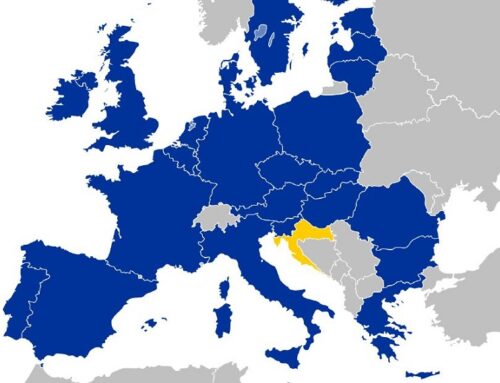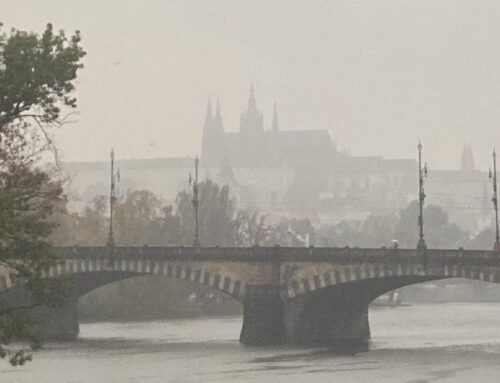Everything is New in the Eastern Front: The Shifting Power Dynamics of Eastern and Central Europe in the Wake of the Ukraine Conflict
In The Power of the Powerless (1978), Havel suggests the decisive nature of the Eastern and Central European communist pasts for the future of the Western states. Historic experience of the formerly communist European states shed light on the importance of the legal order, which in the wake of the post-World War Two post-modernism was taken for granted. The end of history has never come for former communist states, as Russia continued to sabotage their stability and sovereignty, be it the cyber attacks in Estonia or sponsorship of the far-right parties across the region.
American and British secret services were reporting that a full-scale invasion is anticipated in light of Russian military buildup along the Ukrainian border. Despite the warning from the secret service and satellite footage of Russian convoys, many were still convinced that it is a Kremlin bluff, especially among Western scholars.[2] Kassymbekova and Turcanyi argued that Western academia overlooked Russian imperialism, whereas Eastern and Central Europe, given the fresh wounds of history, managed to avoid this fallacy and begin to prepare for the worst as early as 2014. After the annexation of Crimea, Lithuanian leaders declared that Russia had begun waging war on Europe as the country started transitioning from Russian energy supplies.[3] Snyder notably highlighted that for Eastern and Central Europe, Russia’s invasion of Ukraine in 2014 bore an extreme resemblance to the occupations of the twentieth century.[4] Plohii notes Russian Empire is a unique case; Russia developed an empire before developing a nation and it shared common historical roots and myths of inception with foreign subjects.[5] Eastern and Central Europe comprehend this historical peculiarity and its expansive implications. Given this knowledge, there is an understanding that the fight for Ukrainian security is a fight for the security of the Eastern and Central European regions. In 2008, after the Russian invasion of Georgia, the Baltic states and Poland were the only European states that took a firm stand with Tbilisi and urged NATO and the EU to introduce collective punitive measures against Kremlin.[6] The West demonstrated a swifter reaction to the annexation of Crimea, however, Nord Stream 2 project continued to run and Western Europe was among the top trading partners for the Russian state.[7]
In December 2022, Russia issued security demands to limit NATO military activities in Eastern Europe and veto NATO membership for former Soviet republics. Greene argued that the demand is more of a declaration than a treaty by its nature: Putin signalled that post-Soviet space is his sphere of influence.[8] Sphere of influence is a frustrating concept for Central and Eastern Europe, which began to draw similarities with the 1938 Munich agreement or Churchill’s Percentages agreement: Russian troops were massing without substantial backlash from the Western powers. As Germany, the EU’s powerhouse practised an extenuation of the Ostpolitik and Wandel durch Handel (transformation through trade) towards Russia, Eastern and Central Europe grew concerned. Post-Crimea Western sanctions were scrutinised by Eastern and Central Europe as insufficient. According to the Lithuanian Foreign Minister, Lansbergis, Western leaders failed to pay attention to the warnings about Moscow because they thought Eastern and Central European judgment is clouded by the trauma of the Soviet occupation – a concept jokingly known in the region as ‘West-splaining’.[9] Eastern and Central Europe urged for a stronger NATO, in fact per 2021, out of the eight NATO states that did meet the 2% of GDP defence expenditure four were Poland, Estonia, Latvia and Lithuania.[10]
Eastern and Central European warnings about Russian imperial expansion failed to resonate in the West, the full-scale invasion of Ukraine changed that. European geopolitical axis is shifting eastwards, thus giving rise to a new power dynamic within the European Union as Eastern and Central Europe gain weight militarily, economically and politically. This paper will analyse the implications of the Russian war in Ukraine on Eastern and Central Europe and the emerging power shift eastward in the EU. The hypothesis is that the role of the region increased significantly. Military power has been enhanced due to the heightening of the state defence expenditures, being a logistical hub for technological aid for Ukraine, thus getting access to state-of-the-art equipment. Accordingly, the arms industry in the region has enhanced its capabilities and gained international prestige since the start of the war, doubling the revenue and showing reliability with fast and versatile deliveries. The US views Poland as a reliable ally in the turbulent region and it’s probable that American engagement in Eastern and Central Europe will intensify. This heightened involvement could contribute to the development of strong economies in the region, potentially mitigating the economic challenges posed by an ageing population over the long term. The American presence in Eastern and Central Europe will bear some resemblance to the American presence in Western Germany during the Cold War, when it was the frontline of the confrontation with Russia, Accordingly, with accurate assessments of Russia, Eastern and Central Europe has gained a weightier voice, leading to more influence in Brussels and overcoming the confidence crisis previously traceable in the region. Western EU nations are reluctant to assume a leading role in the fight against Russia resulting in a power vacuum, which has been filled by Eastern and Central Europe with Poland and the Baltic states ranking highest GDP-contributing countries. Brexit left the Franco-German alliance to be the motor of the EU, however, the two countries’ national interests fail to align, whereas Eastern and Central Europe began to identify common goals for the region in terms of security, economy and related political decisions. In the coming decades, Eastern and Central Europe is likely to emerge as a regional powerhouse with a major influence in matters of European security. This also involves North-Eastern Europe, specifically Finland as the frontline of the confrontation stretches all along the Russian border. Despite the growing influence of Eastern and Central Europe, Germany and France will remain to be influential EU actors due to the size of their economies.
It must be noted that not all Eastern and Central European states were concerned with Russia. In Hungary, Slovakia and Bulgaria, a pro-Russia sentiment is present both among the elite and the population. On top of Orban and Fico, Zeman also is notorious for his anti-sanction and pro-Russian stance, however, he has apologised for his misreading of Putin and acknowledged his co-responsibility in the war.[11] Unlike the Czechs, a significant proportion of Slovaks and Hungarians mirror the stance of their political elite on Russia. According to a poll by Focus, 44% of Slovaks assume US and NATO were accountable for the tension rise in Ukraine and only 34% reckon Russia was responsible, however, 0,6% of Slovakian GDP is dedicated to aid to Ukraine .[12] Parliamentary elections in September 2023 will be decisive for Slovakian approach towards Ukraine, current polls illustrate strong support for Fico’s party.[13] Only 33% of Bulgarians and 45% of Hungarians deem Russia to be a threat.[14] Sanction support is also the lowest in the three states; additionally, Bulgaria and Hungry are the only two European states, which officially refused arms delivery to Ukraine (previous Bulgarian government secretly supplied Kyiv with fuel and ammunition, concealing it with the public to avoid the belief that Bulgaria is dragged into the conflict).[15] The source of support has to do with the historically less aggressive Russian stance in the region compared to the rest of the region, high-expectations transition from communism that was not met and Russian opportunism.[16] Additionally, Hungary may also be following its territorial aspirations in the Ukrainian Zakarpattia region, where over 150,000 ethnic Hungarians reside, many of whom also have Hungarian passports, despite the Ukrainian ban on dual citizenship.[17] Thus, this paper will focus on the Baltic states and Poland. These countries have strongly developed identity politics Russia-wise. Additionally, the Baltics and Poland are more geographically and historically susceptible to a Russian attack due to the Great European Plain and border-sharing with both Russia and Belarus.
The Czech Republic and Slovakia share completely different outlooks on Russia, despite experiencing Russian occupation as one state. This could potentially be accounted for by different historical experiences prior to the Czechoslovak state. Czech national identity started taking shape relatively early during the Hussite wars, fostering a heightened feeling of self-rule and autonomy, whereas the first Slovak nationalism arose in the 19th century. Czech heightened sense of independence could potentially be traced to the response to Charter 77, which held greater resonance within the Czech population compared to Slovakia.[18]
Military
In 2009, Friedman professed that Eastern Europe could emerge as a major power in the struggle for Russian containment, with Poland being on the frontline.[19] Politicians in neither Berlin nor Paris are eager to take the lead in the confrontation with Russia. Macron endeavoured a policy of a ‘strategic dialogue’ with Putin, whereas Scholz despite the Zeitwende speech, is yet to forth a comprehensive European strategy and embrace a leadership role. An absence of a decisive European Union response leaves a vacuum, which Eastern and Central Europe appear to seize. The eastward reorientation began before the February invasion and was initiated by the Brexit process. The Franco-German alliance, which seems to be at political odds, was left to be the motor of the EU bloc. Consequently, Eastern and Central Europe are turning to the United States for support.
The US has committed the most substantial financial and military assistance to Ukraine, with the military aid and technological resources being channelled through Eastern Europe, particularly Poland, which has emerged as a focal point for technology transfer. The security collaboration between the United States and Poland encompasses the establishment of the Aegis Ashore facility, constituting the fourth instalment of NATO’s European missile defence system.[20] Additionally, the collaboration entails a government-to-government procurement of state-of-the-art equipment valued at $20 billion, excluding private transactions.[21] Poland has submitted a request for 96 AH-64E Apache attack helicopters. Should the proposed deal, amounting to $7 billion, be finalized, Poland would emerge as the second-largest user of Apache helicopters globally, trailing only the US.[22] Further purchases include Patriot air and missile defence system, F-35A Lightning Joint Strike Figthers and HIMARS. The purchase of 316 Abrambs tanks (250 of MIA2 and 116 MIA1) boosts Poland’s land-based power as it becomes the second largest battle tank-owning country in Europe, behind Greece.[23]
The Baltic states have reinstituted conscription, constituting three out of seven NATO countries to do so. The defence budgets of the Baltic states are also anticipated to demonstrate a significant increase by 2027 from 0.9$ billion in 2022 to 1.3$ billion for Estonia and from 1.6$ billion in 2022 to 2.2$ for Lithuania.[24]
Poland is a linchpin for the security of NATO’s Eastern Flank. The Polish government passed legislation, increasing the defence spending to 3% of GDP (the Baltic states agreed to do the same) and proposed doubling the Armed Forces size by 2030. Poland has assumed a prominent position within the anti-Russian coalition during the Ukraine conflict. By 2030, the Polish military is projected to be the most formidable in Europe. This enhancement is attributed to its possession of cutting-edge equipment, a status nurtured through its role as an intermediary for Ukraine aid and its receipt of new orders from the US. The US. is demonstrating a willingness to invest in Poland’s strategic Eastern European Flank, considering it a pivotal stronghold. Poland not only serves as a dependable ally for the United States within the European theatre but also functions as a counterweight to the influence of France and Germany. The robust American connections in Eastern and Central Europe offer a pathway for the US to pursue their security goals in Eastern Europe, especially in regards to Russia. Consequently, it is probable that the United States will persist in providing military and financial backing even after the end of the war.
Poland’s military assistance to Ukraine has reached a total of 3 billion euros, constituting approximately 0.7% of the country’s GDP. In the case of the Baltic states, the percentage is even higher, exceeding 1% of their respective GDPs.[25] Per individual nations, Poland stands fourth-largest to Ukraine’s arms supplies. A distinctive aspect of Eastern and Central European approach is its willingness to provide heavy weaponry, including items such as Mi-24 helicopters, MiG-29 jets, and various types of main battle tanks, a contrast to the cautious stance taken by numerous Western allies.[26] Additionally, as of July 2023, Western allies have only fulfilled half of their commitment to provide heavy weapons, while Eastern and Central European allies have achieved a delivery rate of 80%.[27] Certainly, the heavy weapons pledged by Eastern and Central Europe is facilitated by the smaller amount and closer geographic proximity. Nevertheless, the rapidity of response from the East significantly surpasses that of the Western allies. Although the Baltic states are augmenting their defense expenditures, they remain cognizant that their combined spending will be dawrfed by that of Russia. Consequently, they are focusing on technology, alliances, and regional security. A pivotal aspect of the Baltic states’ new course is the advancement of IT development, an essential component of contemporary warfare, alongside fostering regional w with Nordic countries. The inclusion of Sweden and Finland in NATO has bolstered the security of the Baltic states, mitigating the severity of the Suwalki Gap’s threat, even though the danger persists. The new European geopolitcal axis moved eastward but that also involves the North-East, with Finland and Sweden playing a crucial role in the deterrence of the Russian Baltic fleet stationed in the Gulf of Finland and Kaliningrad.
Economy and politician influence
The war in Ukraine presented an opportunity for the arms industry in Eastern and Central Europe. Through diligent adoption of new technologies and heightened defence expenditures, coupled with the demonstrated reliability of Eastern allies during the conflict, states within Eastern and Central Europe are poised to seize substantial opportunities in entering new markets and augmenting export earnings within the arms industry. This is likely to boost the economies and concurrently enhance their military stature within Europe. PGZ, a Polish state-owned holding, owns more than 50 companies with stakes in dozens more and plans to invest around 1.8$ billion in the next decade. The number is double the pre-war target. The region boasts an extensive history of arms production, originating with figures like Emil Skoda and pivoting during the Cold War as they contributed to Moscow’s supply chain. With a wealth of skilled personnel, material resources, and established production lines, the region is now experiencing heightened demand. The ongoing conflict serves as a catalyst for the industry’s rapid modernization, bolstered by the continuous influx of American technology, alongside the redirection of Soviet-era products to Ukraine. The Czechoslovak Group witnessed a twofold increase in its first-half revenues, reaching 573 million euros. Due to the communist past and NATO present, the factories are capable of manufacturing diverse weapons and ammunition, thereby holding the potential to serve former Russian and Soviet clientele, e.g. African countries.
Having accurately assessed the situation with Russia, the voice of Eastern and Central Europe is now gaining recognition and will persist in doing so. Notably, the vocal insistence from Eastern and Central Europe played a pivotal role in quelling German hesitations and opposition related to supplying Leopard 2 tanks to Ukraine.[28] Moreover, Eastern and Central Europe are becoming increasingly aware of their own potential and recognizing the influence of their collective voice. As they become weary that regional security is in tier hands, these nations are uniting and seeking additional support from Washington. For instance, in the EU discourse regarding the pricing cap for Russian crude oil, Poland and the Baltic states came close to opposing Germany, ultimately achieving a compromise that entails a price review every two months. A collective Eastern and Central European stance is bound to increase in Brussels, with a high likelihood of Northern European states joining the Eastern decisions.
Additionally, EU funding of European integration for Eastern and Central Europe continues, with GDP growth being anticipated. Overall, in the past 30 years, the GDP growth rate of the Eastern Bloc (3,6 %) has exceeded that of Western Europe (2,1%), despite the historical hurdles of the former. [29] The war has the potential to foster additional economic growth, given that the states in the region have acquired heightened political and military influence and gained a significant new economic sector: arms manufacturing. Military strength is often accompanied by economic influence.
In Poland’s case, the conflict has triggered a shift in the perception of immigration policy. While immigrants from the Middle East and Ukraine are still perceived differently, riding the anti-immigration wave could be more arduous for the right-wing leader Duda. Additionally, the war in Ukraine highlights the significance of European unity, potentially complicating Duda’s anti-EU stance. If Tusk were to win the elections, Poland might gain access to the currently restricted 35.4 billion euros – an undoubtful economic stimulus, constituting roughly 5.6% of the country’s total GDP.
European demographics
Europe is the fastest ageing continent with 29.3% and 11.5% of the population being over 60 and 80 respectively by 2060. According to the estimate, Eastern, Central and Southern Europe will suffer most significantly. The aged population is a severe burden on the economy.
Since the reunification of Germany in 1871, it has been the economic powerhouse of Europe with the most dynamic economy, in the upcoming decades Germany is likely to be economically hindered by its ageing population.[30] German European hegemony will be weakened, leaving more power vacuum. Even though Eastern and Central European population is predicted to decline as rapidly as German (or even faster), it is likely that it will be less burdensome for their economies and will not diminish the power of the Eastern bloc that may be formed as a result of this war, for the following reasons:
- The most pivotal factor will be the American involvement in Eastern Europe during and post-war, especially as European dynamics undergo transformation. This engagement from the United States will ensure resilient economies for Eastern and Central Europe.
- Eastern and Central European economies have confronted the challenge of an ageing population for a considerable duration and have managed to navigate this issue while maintaining a growing GDP.
- Another important consideration revolves around the neglect of emerging immigration trends in Eastern and Central Europe when making population projections. This pertains to the influx of immigrants from further Eastern neighbours and, most notably, the return of citizens who had migrated to Western countries over extended periods. To exemplify, Lithuanian surveys indicate that 55.1% of its citizens abroad express a desire to return, and this inclination intensifies over time. As living standards improve in Eastern and Central Europe and the economic uncertainties following the communist era are surmounted, many immigrants desire to return. Consequently, although the population is anticipated to undergo a substantial decline and age, this decline is likely to be less severe than projected by the majority of forecasts.
- The forthcoming Eastern European bloc is expected to encompass Finland and potentially Sweden due to their historical ties, as well as geographic and security proximity to Russia, and the North European population is expected to be the least aged in Europe. Furthermore, if the EU extends its membership, the new entrants are likely to emerge from Eastern regions such as Ukraine, Georgia, or the Balkans.
Nonetheless, even with the burgeoning military, economic, and political influence of Eastern and Central Europe, coupled with an amplified collective voice within the EU, Germany and France will continue to occupy crucial roles in European politics. While Eastern and Central Europe is poised to evolve into a regional hegemon in its designated sphere by projecting power eastward and southward, its dominance is not projected to extend prominently westward. The escalating influence of Eastern and Central Europe hinges significantly on American support. If the United States were to lose interest in the region, there is a likelihood that the traditional European dynamic of Franco-German dominance could resurface. The post-war state of Russia also plays a pivotal role in this progression. In the event of Russian fragmentation, the US might maintain its presence in Eastern and Central Europe to ensure stability. Conversely, if Russia remains within its historical borders, a prolonged American involvement in the region seems less probable.
Conclusion
Irrespective of the ultimate outcome, the conflict in Ukraine has already reshaped the power dynamics in Europe, prompting a reevaluation of Eastern and Central Europe’s role with a shifting geopolitical axis that moves the region away from a peripheral status. Moreover, the standing of Eastern and Central Europe has increased as the region’s accurate assessment of Russia bolstered its credibility. The military and economic development facilitated has further led to enhanced political influence. In the coming decade, the US will view Eastern and Central Europe as a reliable ally in the European region. Consequently, American financial support is likely to increase, alleviating the burden of the ageing population from the region, whereas the issue is likely to be more drastic in Southern and Western Europe.
This growing influence of Eastern and Central Europe has bolstered the region’s growing confidence, solving the prior confidence crisis. It has reaffirmed the significance of the Eastern and Central European voice, which is becoming more assertive and impactful in European politics. Nonetheless, despite these advancements, Eastern and Central Europe is not poised to become a European hegemon, although it possesses the potential to challenge the influence of key players like France and, notably, Germany. In the upcoming decade, Eastern and Central Europe is likely to pursue collective regional goals, broadcasting its power and influence mostly eastward and southward. The duration and the degree of the challenge to the established European power structure heavily hinges on the continued American involvement in the region.
Thus, the Ukrainian War has contributed to the shifting dynamics in European power structures. It has further increased the power vacuum, which first appeared after Brexit and has enabled Eastern and Central Europe to enhance the power of its voice militarily, economically and politically.
References:
[2] https://www.thehindu.com/books/books-authors/mark-galeotti-putin-wars-russia-ukraine-conflict-book/article66329657.ece; https://www.aljazeera.com/opinions/2023/1/24/how-western-scholars-overlooked-russian-imperialism and https://www.forces.net/news/world/nato-which-countries-pay-their-share-defence
[3] https://www.csmonitor.com/World/Europe/2022/0815/Eyeing-Russia-Lithuania-prepped-for-energy-Independence-years-ago
[4] Power of the
[5] P.22
[6] History matters laas
[7] https://www.euronews.com/my-europe/2022/03/03/ukraine-war-did-eastern-europe-s-russia-warnings-fall-on-deaf-ears
[8] https://www.reuters.com/world/russia-unveils-security-guarantees-says-western-response-not-encouraging-2021-12-17/#:~:text=MOSCOW%2C%20Dec%2017%20(Reuters),to%20negotiate%20with%20the%20West.
[9] https://www.washingtonpost.com/world/2022/10/12/baltics-poland-russia-warnings-nato/
[10] https://www.forces.net/news/world/nato-which-countries-pay-their-share-defence
[11] https://www.euronews.com/my-europe/2022/05/05/milos-zeman-is-czech-president-s-remorse-genuine-over-his-pro-russian-stance
[12] https://www.euronews.com/my-europe/2022/03/03/ukraine-war-did-eastern-europe-s-russia-warnings-fall-on-deaf-ears
[13] https://www.politico.eu/europe-poll-of-polls/slovakia/
[14] https://www.aljazeera.com/opinions/2023/2/6/why-some-eu-countries-still-harbour-pro-russian-sentiments
[15] https://europa.eu/eurobarometer/surveys/detail/2932
[16] https://www.aljazeera.com/opinions/2023/2/6/why-some-eu-countries-still-harbour-pro-russian-sentiments
[17] https://hhrf.org/on-our-radar/hungarians-in-ukraine/
[18] https://www.upn.gov.sk/data/files/skladacky-2017-11_12.pdf
[19] Ithe next 100 years
[20] https://www.state.gov/u-s-security-cooperation-with-poland/
[21] https://www.state.gov/u-s-security-cooperation-with-poland/
[22] https://www.state.gov/u-s-security-cooperation-with-poland/
[23] https://www.statista.com/statistics/1294391/nato-tank-strength-country/ https://www.defensenews.com/global/europe/2023/01/04/poland-signs-deal-to-buy-2nd-batch-of-us-abrams-tanks/
[24]https://www.army-technology.com/special-focus/ukraine-crisis/baltic-military-acquisitions-grow-in-significance-as-russias-threat-expands/?cf-view#:~:text=GlobalData%20Estonia%20defence%20market%20report https://www.army-technology.com/special-focus/ukraine-crisis/baltic-military-acquisitions-grow-in-significance-as-russias-threat-expands/?cf-view#:~:text=GlobalData%E2%80%99s%20armed%20forces%20equipment%20inventory
[25] https://www.ifw-kiel.de/topics/war-against-ukraine/ukraine-support-tracker/
[26] https://defence24.com/defence-policy/we-know-the-value-of-polish-military-aid-to-ukraine-exclusive
[27] https://www.businessinsider.com/only-half-of-heavy-weapons-promised-to-ukraine-delivered-experts-2023-7
[28] https://www.nytimes.com/2023/01/26/world/europe/eu-nato-power-ukraine-war.html
[29] https://ec.europa.eu/eurostat/databrowser/view/tec00115/default/table?lang=en; https://ec.europa.eu/eurostat/databrowser/view/sdg_08_10/default/table; https://ec.europa.eu/eurostat/databrowser/view/NAMA_10_GDP/default/table?lang=en&category=na1
[30] Friedman , p. 228





